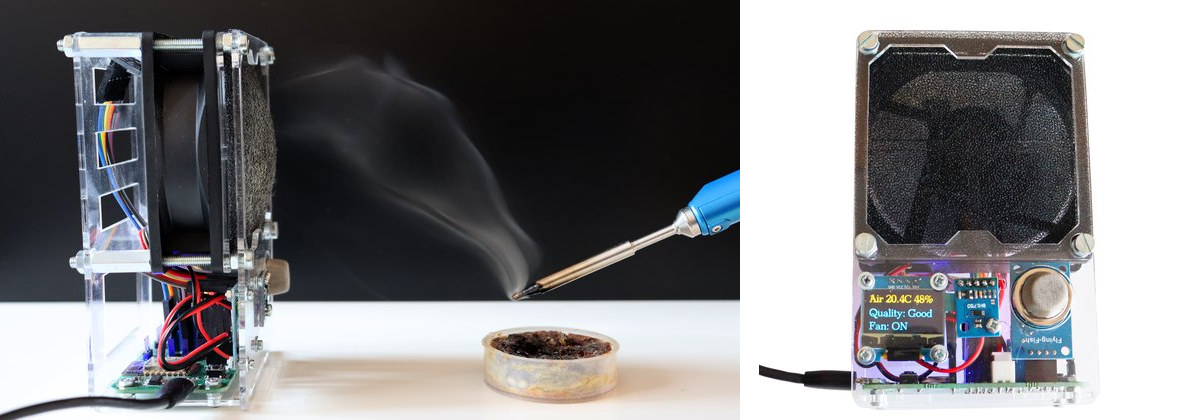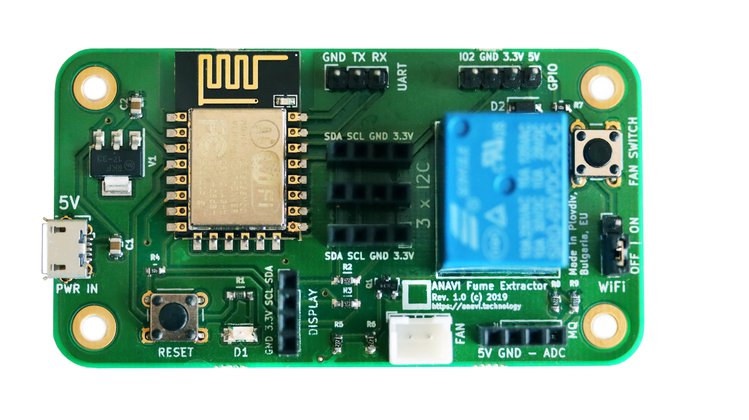Last year, I played with ESP8266 based ANAVI Gas Detector Starter Kit reporting air quality via an MQ135 sensor on an OLED display, and integrated it with Home Assitant to monitor air quality from a neat web dashboard.
The developer, Leon ANAVI, has now adapted the design to create ANAVI Fume Extractor by basically adding a relay to control a control. The fan can be turned on/off manually, or automatically upon detecting bad air quality.

ANAVI Fume Extractor key features and specifications:
- Fan – 80 mm, 5 V DC, 0.25 A with replaceable filter
- SoC – ESP8266 Tensilica L106 32-bit wireless processor
- Connectivity – 802.11 b/g/n Wi-Fi 4
- Display – Mini OLED display
- Sensors – Optional MQ-135 for air quality or any other 5V MQ analog gas sensor
- Expansion – 3x headers for I²C sensors
- Debugging / Programming – UART pins for flashing custom firmware,
- Misc – Button, WiFi on/off jumper
- Dimensions – 129 x 80x 54 mm
- Certification – Open Source Hardware Association (OSHWA) BG000060 – (KiCad hardware design files are available on Github)
 If you are only going to use the platform as a fume extractor, there’s no need for network connectivity, and there’s a jumper that will disable WiFi. Just like previous ANAVI boards, it can be programmed with the Arduino IDE or PlatformIO (see sample sketch & docs), and you could easily integrate it with Home Assistant, OpenHAB, ThingSpeak, MQTT, … and/or control it with any modern web browser.
If you are only going to use the platform as a fume extractor, there’s no need for network connectivity, and there’s a jumper that will disable WiFi. Just like previous ANAVI boards, it can be programmed with the Arduino IDE or PlatformIO (see sample sketch & docs), and you could easily integrate it with Home Assistant, OpenHAB, ThingSpeak, MQTT, … and/or control it with any modern web browser.
ANAVI Fume Extractor has recently launched on Crowd Supply where you can get a starter kit with the fan, two filters, the board, an enclosure and the display for $49, but if you pledge $59 for the advanced kit you’d also get MQ-135 gas sensor and HTU21D temperature & humidity sensor on top. The developer kit further adds a light sensor and a barometric sensor for a total of $69. Shipping is free to the US, adds $12 to $20 to the rest of the world, and deliveries are scheduled to start at the end of October 2020.

Jean-Luc started CNX Software in 2010 as a part-time endeavor, before quitting his job as a software engineering manager, and starting to write daily news, and reviews full time later in 2011.
Support CNX Software! Donate via cryptocurrencies, become a Patron on Patreon, or purchase goods on Amazon or Aliexpress. We also use affiliate links in articles to earn commissions if you make a purchase after clicking on those links.




Isn’t it a bit strange to employ a big and energy-consuming relay when fans are usually controlled by a tiny transistor, typically the same as the one used to control the relay ?
Also using transistors it’s possible to PWM the fan and make it run at different speeds depending on the concentration of gas.
Good question. I’ve decided to use this relay because I already have some units in stock from other open source projects. It is reliable and low-cost relay with a common footprint that can be easily replaced with compatible similar relays from other supplier. This keeps bill of materials low and simplifies the source and manufacturing processes.
Although PWM and changeable fan speed sounds cool, in practice it is useful only for big powerful fans. One of the key features of ANAVI Fume Extractor is its compatibility achieved with 80mm 5V fan which is not so powerful and needs to work on max speed when turned on.
OK Leon, but I’m pretty sure that if you connect your fan directly to the relay coil’s pins it will work equally well with one less component 🙂 Especially if you used a small MOSFET like 2N7000 or so to turn the relay on.
Depending how this is wired (relay connecting the + or the – of the fan), it may even be possible to achieve this by replacing the relay with a strap between the coil’s pin and the output one. Of course if you control the positive terminal and the relay is activated from the negative one this cannot be done.
Don’t worry though, I’m not criticizing your project, I was even wondering if something like this could be useful for my soldering sessions, which is what made me wonder about the relay 🙂
Thanks for taking the time to review it and for spreading the word about ANAVI Fume Extractor! It means a lot of a small open source project like this to be covered in popular websites like cnx-software.
By the way, I think that with possibly no hardware mods, and by adjusting only the software, you might be able to adapt this as a moist extractor for bathrooms, just by relying on the elevated temperature that results from a shower or bath. That’s typically a place where you don’t need something strong and noisy but rather like this, which works for the required time. It might also work for kitchens but there usually you’ll need a stronger fan.
This is a cool idea! Thanks for sharing it. I will give it a try in the kitchen.